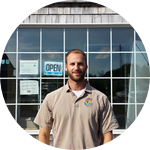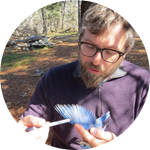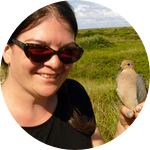Project Results
Fall 2018 was a slow but exciting migration season on Monomoy. Although the capture rates were lower than previous years, we banded four new species - Black-billed Cuckoo, Connecticut Warbler, Kentucky Warbler and Common Redpoll - and observed strong waves of Common Yellowthroats, Red-breasted Nuthatches and sparrows. Our 2018 report details the project and protocols and provides a full picture of the birds banded and observed this fall on Monomoy.
About This Project
With the cooperation of US Fish and Wildlife and Monomoy National Wildlife Refuge, Monomoy Bird Observatory monitors the fall migration passage of millions of songbirds, shorebirds, seabirds and ducks that depend on the refuge to rest and refuel.
Employing standardized protocols for constant-effort banding and visual counts, we collect data to support informed management and conservation on the Refuge and across Cape Cod.
Ask the Scientists
Join The DiscussionWhat is the context of this research?
Out on the edge of the continent where the North Atlantic meets the Gulf Current, Monomoy is a perfect haven for breeding and migrating birds. Beyond valuable breeding grounds, it provides key stopover and refueling opportunities for millions of migrating shorebirds, seabirds, ducks and songbirds each year.
Migration is the most dangerous part of a birds life. Traveling long distances across unfamiliar areas exposed to predators and rough weather leads to a mortality rate over ten times higher than other periods of a bird's year.
Our research documents the birds using Monomoy during migration and staging. The data collected is used to make management decisions that will benefit the birds during this stressful stage.
What is the significance of this project?
Coastal habitats in the Northeastern United States are among the most impacted habitats in North America, with only a fraction remaining in a natural state.
Monomoy NWR is the only coastal Wilderness Area in Southern New England. Encompassing dunes, beaches, intertidal, saltmarsh, freshwater ponds and tidal rips, it hosts a 10,000+ Common Tern colony and significant breeding colonies of Piping Plovers and American Oystercatchers.
Quality habitat also makes it a key staging site for migrating birds. The ponds and trees around the lighthouse attract rare songbirds, including Bobolink, Lark Sparrow and Western vagrants.
Without the banding station, these species would be otherwise undocumented, as this project is the only organized effort to monitor migrating birds on Monomoy.
What are the goals of the project?
Our goal is to accurately document the diversity of migrating birds on the refuge so we can better manage the habitat to their benefit. It is also vital to share this knowledge with the public and make them aware of this unique birding haven.
From Aug 15 to Oct 31, we band each morning, then conduct a visual survey at one of three sites in the afternoon. We document the age/sex and condition of each bird banded, and our study design allows us to measure inter-annual changes in species diversity and abundance.
Visual surveys account for species that we do not band. They are conducted alternately at Lighthouse Beach for seaducks and seabirds, Powder Hole for shorebirds and terns, and Big Station for marsh ducks. Shared on eBird, these counts provide valuable data on key species.
Budget
Monomoy National Wildlife Refuge is located on a remote island location, and while access is graciously granted by U.S. Fish and Wildlife, the project requires some logistical support in the form of transportation, food and supplies for the small team of researchers who must live at the station for 11 weeks.
The banding station has been in operation since 2011 and has all the staff and equipment in place for a successful fall season in 2018. Funds raised will provide the most basic necessities for the researchers operating the station: food for two researchers over 11 weeks and transportation to and from the island. Only a minor portion of the budget is dedicated to fundraising, public outreach and dissemination of findings.
Endorsed by
 Project Timeline
Project Timeline
The Fall field season is scheduled based on peak migration from mid-August to November 1.
Aug. 15 - Arrival on Monomoy, banding station setup
Aug. 16-27 - Daily banding and census, weather permitting
Aug. 27-30 - Second team on Monomoy for training
Sept. 1-Oct. 31 - Two team of two researchers alternate 3-week stays on the island
Dec. 15 - Data transcribed and submitted to USFWS and the Bird Banding Lab
Dec. 31 - Full report submitted to USFWS and available online
Jul 01, 2018
Recruitment of second bander and tech
Jul 04, 2018
Project Launched
Aug 15, 2018
Field season begins on Monomoy
Oct 31, 2018
Field season ends on Monomoy
Dec 15, 2018
Banding data submitted
Meet the Team
Affiliates
Team Bio
Monomoy Bird Observatory is run by James Junda and Valerie Bourdeau, the scientific and outreach arms of the organization. They work together to formulate, collect, analyze and disseminate the data, as well as share their love of birds and passion for conservation to the public.
The team is composed of trained banders and enthusiastic volunteers who have a unique opportunity to practice valuable field research skills in scenic locations on Cape Cod.
James Henderson Junda
An experienced field biologist. James has been interested in wildlife since he was a small child. This interest was fostered during his summers on Cape Cod chasing frogs and walking the seashore, with its diversity of fascinating lifeforms.
James graduated with a Bachelors of Zoology from Oregon State University and later a Masters of Wildlife Biology from McGill University. Having conducted numerous field studies over 13 years in 6 countries, James has become a very skilled and versatile field biologist.
James current interests focus on passerine migration in coastal areas and molt as it relates to survivorship and migration. He also is focused on conservation through public outreach, such as educational demos, social media and volunteer engagement and citizen science. Along with the Monomoy banding station, he currently runs a second station at MassAudubon's Wellfleet Bay Wildlife Sanctuary.
He is in the process of launching a collection MAPS banding stations in Uruguay that will focus on productivity, molt patterns and survivorship of resident grassland, forest and marsh species, as well as local outreach. The long-term goal for these stations is to connect researchers from both countries and provide opportunities for collaborative research with Uruguayan biologists and conservationists.
Valerie Bourdeau
From her very first taste of bird research on Monomoy in 2013, Val has been hooked! As a volunteer assistant on most MOBO projects, she developed strong bird handling skills and provided technical assistance in the field, while also growing the outreach and online components of the project.
She is currently working on a long-term study of the Pine Warblers that breed in the forest of Wellfleet Bay Wildlife Sanctuary.
Project Backers
- 30Backers
- 100%Funded
- $3,402Total Donations
- $113.40Average Donation


